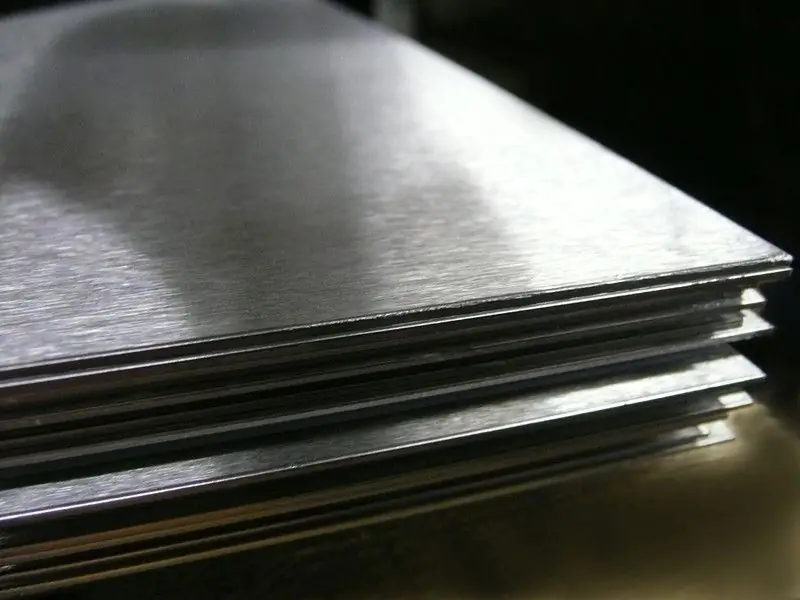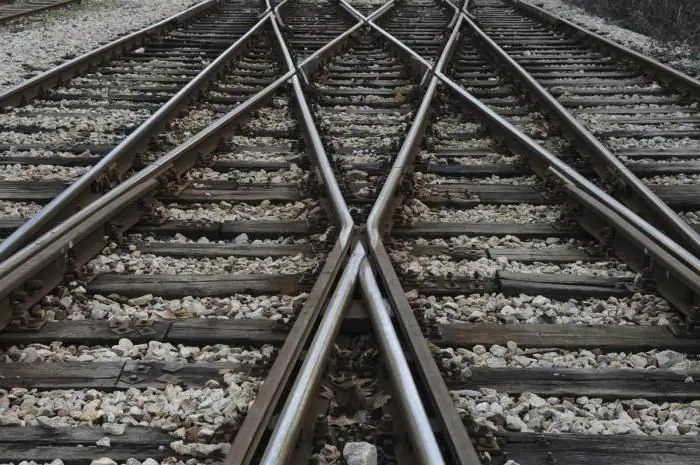2025 Author: Howard Calhoun | [email protected]. Last modified: 2025-01-24 13:10:30
Low carbon steel is ubiquitous. Its popularity is based on physical, chemical properties and low cost. This alloy is widely used in industry and construction. Let's take a closer look at this type of steel.
Composition
Steel is iron enriched with carbon during the smelting process. Carbon smelting is characterized by the presence of carbon, which determines the basic properties of the metal, and impurities: phosphorus (up to 0.07%), silicon (up to 0.35%), sulfur (up to 0.06%), manganese (up to 0.8%). So, mild steel contains no more than 0.25% carbon.

As for other additives, manganese and silicon serve to deoxidize (remove oxygen from the liquid metal, which reduces brittleness during hot deformation). But an increased percentage of sulfur can lead to cracking of the alloy during heat treatment, phosphorus - during cold treatment.
Methods of obtaining
The production of a low-carbon alloy can be decomposed into several stages: loading iron and scrap (charge) into the furnace, thermal treatment to a melting state, removal of impurities from the mass.

Next, steel casting or additional processing can occur: with slag or vacuum and inert gases.
Three ways are used to execute such processes:
- Open-hearth furnaces. The most common equipment. The melting process takes place within a few hours, which allows laboratories to track the quality of the resulting composition.
- Convector ovens. Produced by purging with oxygen. It should be noted that the alloys obtained in this way are not of high quality, as they contain more impurities.
- Induction and electric furnaces. The production process goes with the use of slag. In this way, high-quality and specialized alloys are obtained.
Let's consider the features of the classification of alloys.
Views
Low carbon steel can be of three types:
- Regular quality. In such alloys, the sulfur content does not exceed 0.06%, phosphorus 0.07%.
- Quality. Contains: sulfur up to 0.04%, phosphorus up to 0.035%.
- High quality. Sulfur up to 0.025%, Phosphorus up to 0.025%
- Special quality. Low impurity content: sulfur up to 0.015%, phosphorus - up to 0.025%.
As mentioned earlier, the less impurities, the better the quality of the alloy.

Low-carbon steel GOST 380-94 of ordinary quality is divided into three more groups:
- A. Defined by its mechanicalproperties. The form of delivery to the consumer is most often found in the form of multi-section and sheet metal.
- B. The main indicators are the chemical composition and properties. Optimal for mechanical action by pressure under the thermal factor (forging, stamping).
- B. For these types of alloys, the following properties are important: technical, technological, physical, chemical and, accordingly, composition.
According to the process of deoxidation, steel is divided into:
- Calm. The curing process is going smoothly. No gases are released during this process. Shrinkage occurs in the middle of the ingot.
- Semi-calm. An intermediate view of steel between calm and boiling compositions.
- Boiling. Solidification occurs with the release of gas. Concealed shrink sleeve.
Basic Features
Low-carbon steel has high ductility, easy to deform in cold state and hot. A distinctive feature of this alloy is good weldability. Depending on the additional elements, the properties of the steel may change.

Most often, low-carbon alloys are used in construction and industry. This is due to the low price and good strength properties. Such an alloy is also called structural. The properties of low carbon steel are encrypted in the marking. Below we will look at its features.
Marking Features
Ordinary mild steel has the letter CT and the number. The number should be divided by 100, then it will beunderstand the percentage of carbon. For example, CT15 (carbon 0.15%).
Let's consider the marking and decipher the designations:
- The first letters or their absence indicates belonging to a particular quality group. It can be B or C. If there is no letter, then the alloy belongs to category A.
- St stands for steel.
- Numerical designation - encrypted percentage of carbon.
- kp, ps - denotes a boiling or semi-calm alloy. The absence of a designation indicates that the steel is calm (cn).
- The letter designation and the number after it reveal what impurities are included in the composition, and their percentage. For example, G - manganese, Yu - aluminum, F - vanadium.
For high-quality low-carbon steels, the letter “St” is not put in the marking.

Also applies color coding. For example, grade 10 mild steel is white. Special purpose steels may be designated by additional letters. For example, "K" - is used in boiler building; OSV - used for the manufacture of wagon axles, etc.
Manufactured products
Several groups of steel products can be distinguished:
- Sheet steel. Subspecies: thick sheet (GOST 19903-74), thin sheet (GOST 19904-74), broadband (GOST 8200-70), strip (GOST 103-76), corrugated (GOST 8568-78)
- Angle profiles. Equal-shelf (GOST 8509-93), unequal-shelf (GOST 8510-86).
- Channels (GOST 8240-93).
- I-beams. Ordinary I-beams (GOST 8239-89), Wide-shelf I-beams (GOST 26020-83, STO ASCHM 20-93).
- Pipes.
- Profiled flooring.
Secondary profiles are added to this list, which are formed by welding and machining.
Application areas
The scope of low carbon steel is quite wide and depends on the marking:
- St 0, 1, 3Gsp. Wide application in construction. For example, mild steel reinforcing wire,
- 05kp, 08, 08kp, 08y. Good for stamping and cold drawing (high plasticity). Used in the automotive industry: body parts, fuel tanks, coils, parts of welded structures.
- 10, 15. Used for parts that are not subjected to high loads. Boiler pipes, stampings, couplings, bolts, screws.
- 18kp. A typical application is structures that are produced by welding.
- 20, 25. Widely used for the production of fasteners. Couplings, valve tappets, frames and other parts of agricultural machines.
- 30, 35. Lightly loaded axles, sprockets, gears, etc.
- 40, 45, 50. Medium load parts. For example, crankshafts, friction discs.
- 60-85. Parts subjected to high stress. It can be railroad tracks, crane wheels, springs, washers.
As you can see, the product range is extensive - it is not only mild steel wire. Alsothese are the details of complex mechanisms.
Low-alloy and low-carbon steel: differences
To improve any characteristics of the alloy, alloying elements are added.

Steels that contain a low amount of carbon (up to a quarter of a percent) and alloying additives (a total percentage of up to 4%) in cheba are called low-alloyed. Such rolled products retain high weldability, but at the same time, different properties are enhanced. For example, strength, anti-corrosion performance and so on. As a rule, both types are used in welded structures, which must withstand a temperature range from minus 40 to plus 450 degrees Celsius.
Welding features
Welding of low carbon steels has a high performance. The type of welding, electrodes and their thickness are selected based on the following technical data:
- The connection must certainly be firmly fastened.
- There must be no seam defects.
- The chemical composition of the seam must be carried out in accordance with the standards specified in GOST.
- Welded joints must comply with the operating conditions (resistance to vibration, mechanical stress, temperature conditions).
Various types of welding can be used from gas to carbon dioxide consumable electrode welding. When selecting, take into account the high fusibility of low-carbon and low-alloy alloys.
With regard to the specific application, low-carbon steel is used in construction and engineering.

The steel grade is selected based on the required physical and chemical properties at the output. The presence of alloying elements can improve some properties (resistance to corrosion, temperature extremes), but also worsen others. Good weldability is another advantage of these alloys.
So, we found out what low-carbon and low-alloy steel products are.
Recommended:
Steel 10HSND: characteristics, properties, composition

Sometimes it can be very useful to have a short excerpt in front of your eyes, containing all the most important information on a particular issue. This article is such an excerpt, which contains all the most important information about 10KhSND steel: characteristics, its application, composition and properties
Food stainless steel: GOST. How to identify food grade stainless steel? What is the difference between food stainless steel and technical stainless steel?

The article talks about grades of food grade stainless steel. Read how to distinguish food stainless steel from technical
Consumer credit with a low interest rate. Sberbank consumer loans with a low interest rate

Consumer credit with a low interest rate is real. You just need to clearly understand what is meant by a low interest rate and under what conditions it can be obtained. And, accordingly, with which banks it is more profitable to cooperate today
Steel: composition, properties, types and applications. Composition of stainless steel

Today, steel is used in the vast majority of industries. However, not everyone knows that the composition of steel, its properties, types and applications are very different from the production process of this product
Where can I get a loan at a low interest rate? Low interest loan

Most of the population of Western countries has long been accustomed to exist on credit, and in Russia to live in debt every year is becoming more familiar. In this regard, the question of how to get a consumer loan at low interest rates occupies the minds of many of our fellow citizens

